Entrepreneurship and Business Development: Vegan Skincare Analysis
VerifiedAdded on 2023/06/18
|17
|4449
|491
Report
AI Summary
This report outlines a new vegan skincare business concept, detailing the product service, target market, special attributes, values, scale of business, location, and key stakeholders. It assesses industry, market, organizational, and financial feasibility using PESTEL and SWOT analyses. The report examines the value chain and business model canvas in the context of the proposed business, identifying potential risks and providing mitigation strategies. The analysis highlights the growing organic skincare market in the UK, driven by increasing consumer awareness of sustainability and health, making a compelling case for launching an affordable, organic, and sustainable skincare range. The competitive advantage lies in offering affordable sustainable products, targeting environmentally conscious middle and high-income consumers through digital and physical distribution channels, with a market penetration strategy aimed at maximizing market share in the UK before expanding internationally. Desklib is your go-to resource for similar solved assignments and study tools.
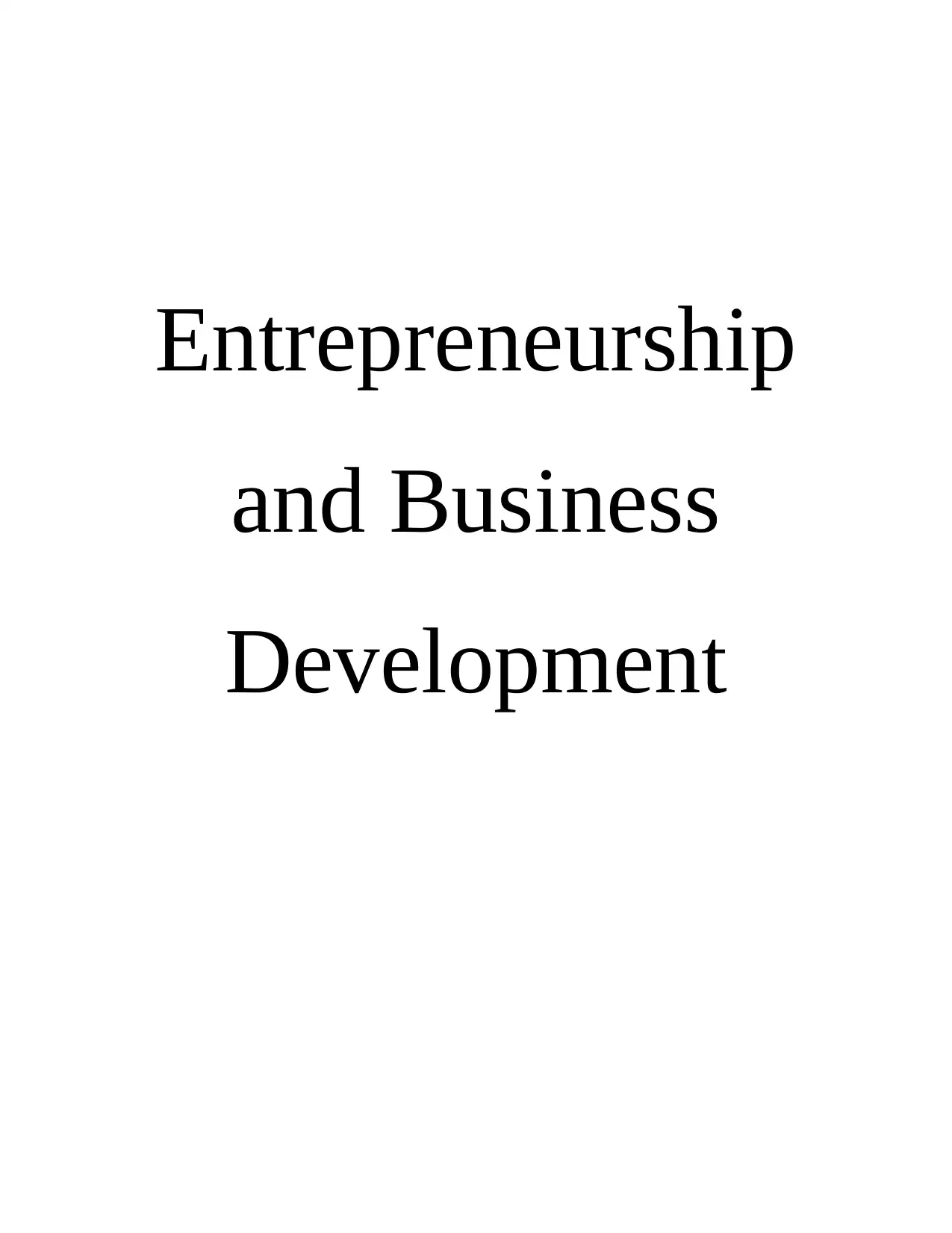
Entrepreneurship
and Business
Development
and Business
Development
Paraphrase This Document
Need a fresh take? Get an instant paraphrase of this document with our AI Paraphraser
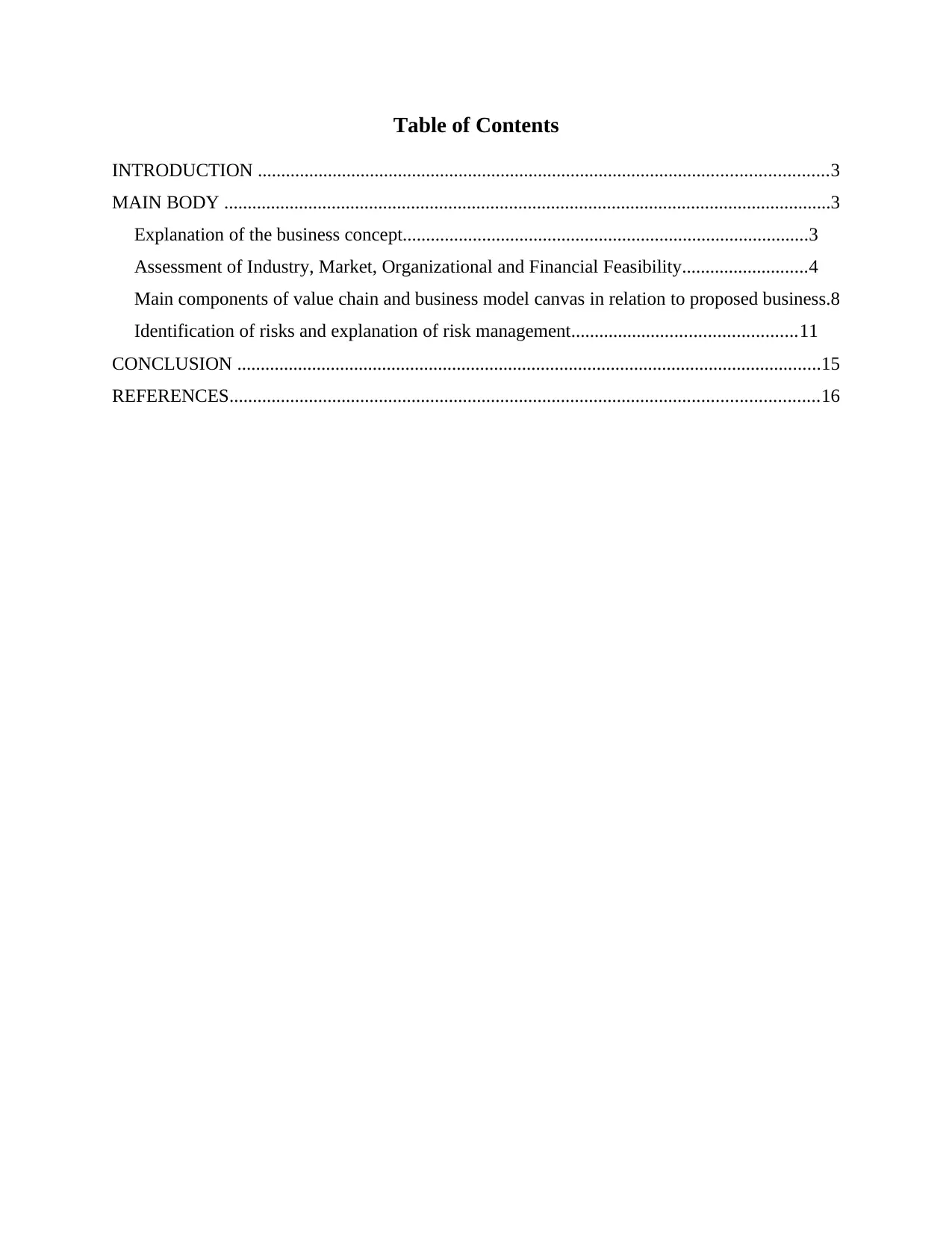
Table of Contents
INTRODUCTION ..........................................................................................................................3
MAIN BODY ..................................................................................................................................3
Explanation of the business concept.......................................................................................3
Assessment of Industry, Market, Organizational and Financial Feasibility...........................4
Main components of value chain and business model canvas in relation to proposed business.8
Identification of risks and explanation of risk management................................................11
CONCLUSION .............................................................................................................................15
REFERENCES..............................................................................................................................16
INTRODUCTION ..........................................................................................................................3
MAIN BODY ..................................................................................................................................3
Explanation of the business concept.......................................................................................3
Assessment of Industry, Market, Organizational and Financial Feasibility...........................4
Main components of value chain and business model canvas in relation to proposed business.8
Identification of risks and explanation of risk management................................................11
CONCLUSION .............................................................................................................................15
REFERENCES..............................................................................................................................16
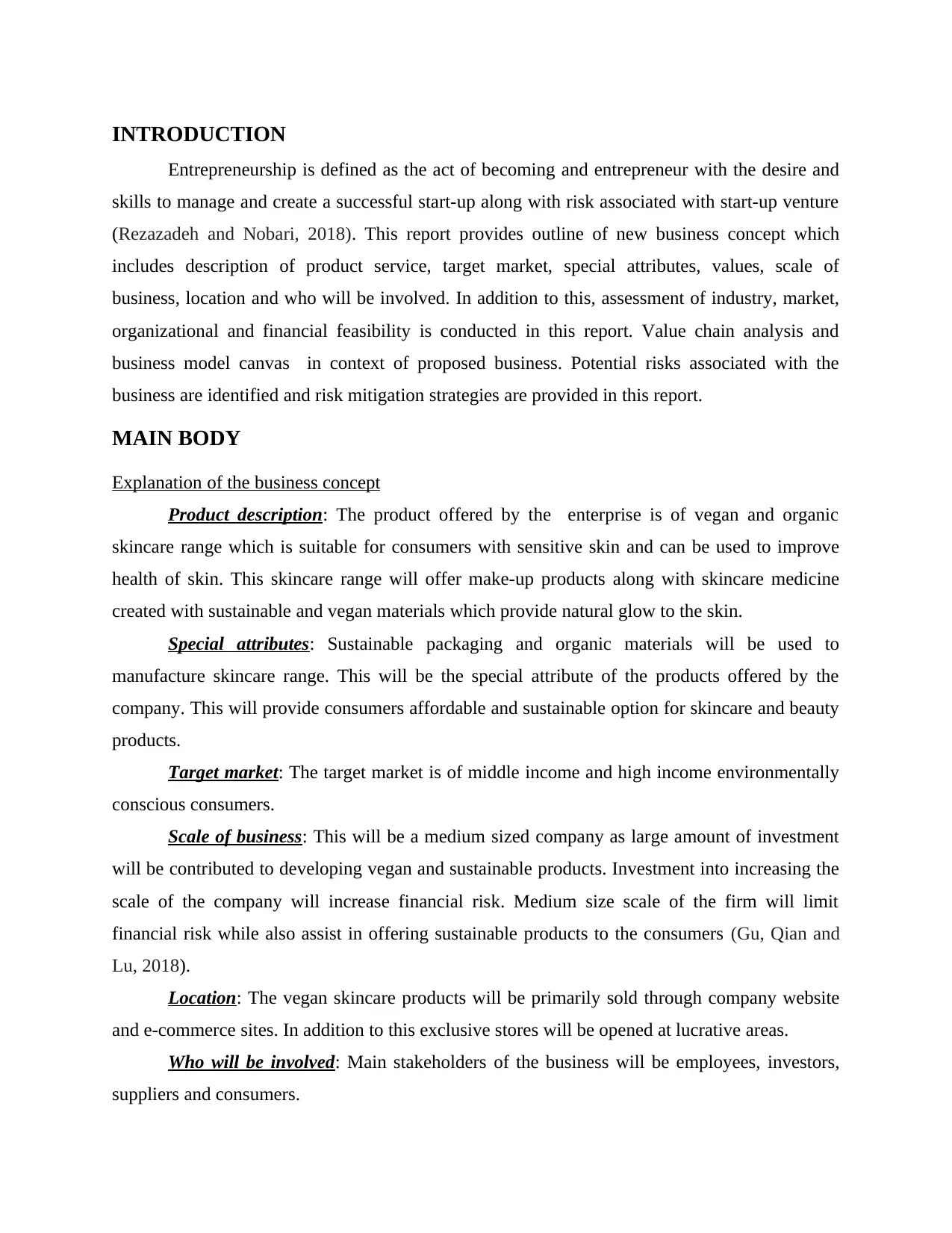
INTRODUCTION
Entrepreneurship is defined as the act of becoming and entrepreneur with the desire and
skills to manage and create a successful start-up along with risk associated with start-up venture
(Rezazadeh and Nobari, 2018). This report provides outline of new business concept which
includes description of product service, target market, special attributes, values, scale of
business, location and who will be involved. In addition to this, assessment of industry, market,
organizational and financial feasibility is conducted in this report. Value chain analysis and
business model canvas in context of proposed business. Potential risks associated with the
business are identified and risk mitigation strategies are provided in this report.
MAIN BODY
Explanation of the business concept
Product description: The product offered by the enterprise is of vegan and organic
skincare range which is suitable for consumers with sensitive skin and can be used to improve
health of skin. This skincare range will offer make-up products along with skincare medicine
created with sustainable and vegan materials which provide natural glow to the skin.
Special attributes: Sustainable packaging and organic materials will be used to
manufacture skincare range. This will be the special attribute of the products offered by the
company. This will provide consumers affordable and sustainable option for skincare and beauty
products.
Target market: The target market is of middle income and high income environmentally
conscious consumers.
Scale of business: This will be a medium sized company as large amount of investment
will be contributed to developing vegan and sustainable products. Investment into increasing the
scale of the company will increase financial risk. Medium size scale of the firm will limit
financial risk while also assist in offering sustainable products to the consumers (Gu, Qian and
Lu, 2018).
Location: The vegan skincare products will be primarily sold through company website
and e-commerce sites. In addition to this exclusive stores will be opened at lucrative areas.
Who will be involved: Main stakeholders of the business will be employees, investors,
suppliers and consumers.
Entrepreneurship is defined as the act of becoming and entrepreneur with the desire and
skills to manage and create a successful start-up along with risk associated with start-up venture
(Rezazadeh and Nobari, 2018). This report provides outline of new business concept which
includes description of product service, target market, special attributes, values, scale of
business, location and who will be involved. In addition to this, assessment of industry, market,
organizational and financial feasibility is conducted in this report. Value chain analysis and
business model canvas in context of proposed business. Potential risks associated with the
business are identified and risk mitigation strategies are provided in this report.
MAIN BODY
Explanation of the business concept
Product description: The product offered by the enterprise is of vegan and organic
skincare range which is suitable for consumers with sensitive skin and can be used to improve
health of skin. This skincare range will offer make-up products along with skincare medicine
created with sustainable and vegan materials which provide natural glow to the skin.
Special attributes: Sustainable packaging and organic materials will be used to
manufacture skincare range. This will be the special attribute of the products offered by the
company. This will provide consumers affordable and sustainable option for skincare and beauty
products.
Target market: The target market is of middle income and high income environmentally
conscious consumers.
Scale of business: This will be a medium sized company as large amount of investment
will be contributed to developing vegan and sustainable products. Investment into increasing the
scale of the company will increase financial risk. Medium size scale of the firm will limit
financial risk while also assist in offering sustainable products to the consumers (Gu, Qian and
Lu, 2018).
Location: The vegan skincare products will be primarily sold through company website
and e-commerce sites. In addition to this exclusive stores will be opened at lucrative areas.
Who will be involved: Main stakeholders of the business will be employees, investors,
suppliers and consumers.
⊘ This is a preview!⊘
Do you want full access?
Subscribe today to unlock all pages.

Trusted by 1+ million students worldwide
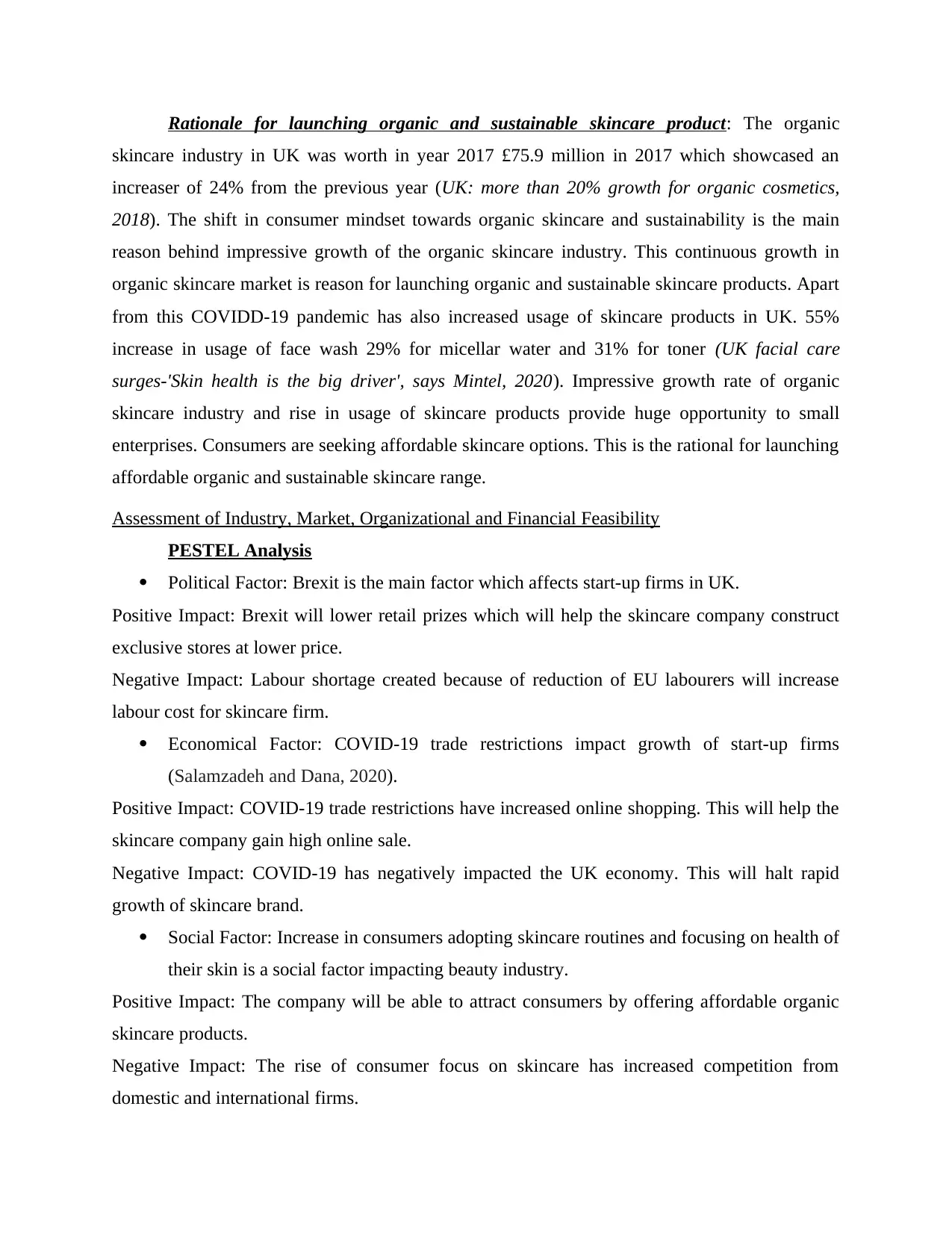
Rationale for launching organic and sustainable skincare product: The organic
skincare industry in UK was worth in year 2017 £75.9 million in 2017 which showcased an
increaser of 24% from the previous year (UK: more than 20% growth for organic cosmetics,
2018). The shift in consumer mindset towards organic skincare and sustainability is the main
reason behind impressive growth of the organic skincare industry. This continuous growth in
organic skincare market is reason for launching organic and sustainable skincare products. Apart
from this COVIDD-19 pandemic has also increased usage of skincare products in UK. 55%
increase in usage of face wash 29% for micellar water and 31% for toner (UK facial care
surges-'Skin health is the big driver', says Mintel, 2020). Impressive growth rate of organic
skincare industry and rise in usage of skincare products provide huge opportunity to small
enterprises. Consumers are seeking affordable skincare options. This is the rational for launching
affordable organic and sustainable skincare range.
Assessment of Industry, Market, Organizational and Financial Feasibility
PESTEL Analysis
Political Factor: Brexit is the main factor which affects start-up firms in UK.
Positive Impact: Brexit will lower retail prizes which will help the skincare company construct
exclusive stores at lower price.
Negative Impact: Labour shortage created because of reduction of EU labourers will increase
labour cost for skincare firm.
Economical Factor: COVID-19 trade restrictions impact growth of start-up firms
(Salamzadeh and Dana, 2020).
Positive Impact: COVID-19 trade restrictions have increased online shopping. This will help the
skincare company gain high online sale.
Negative Impact: COVID-19 has negatively impacted the UK economy. This will halt rapid
growth of skincare brand.
Social Factor: Increase in consumers adopting skincare routines and focusing on health of
their skin is a social factor impacting beauty industry.
Positive Impact: The company will be able to attract consumers by offering affordable organic
skincare products.
Negative Impact: The rise of consumer focus on skincare has increased competition from
domestic and international firms.
skincare industry in UK was worth in year 2017 £75.9 million in 2017 which showcased an
increaser of 24% from the previous year (UK: more than 20% growth for organic cosmetics,
2018). The shift in consumer mindset towards organic skincare and sustainability is the main
reason behind impressive growth of the organic skincare industry. This continuous growth in
organic skincare market is reason for launching organic and sustainable skincare products. Apart
from this COVIDD-19 pandemic has also increased usage of skincare products in UK. 55%
increase in usage of face wash 29% for micellar water and 31% for toner (UK facial care
surges-'Skin health is the big driver', says Mintel, 2020). Impressive growth rate of organic
skincare industry and rise in usage of skincare products provide huge opportunity to small
enterprises. Consumers are seeking affordable skincare options. This is the rational for launching
affordable organic and sustainable skincare range.
Assessment of Industry, Market, Organizational and Financial Feasibility
PESTEL Analysis
Political Factor: Brexit is the main factor which affects start-up firms in UK.
Positive Impact: Brexit will lower retail prizes which will help the skincare company construct
exclusive stores at lower price.
Negative Impact: Labour shortage created because of reduction of EU labourers will increase
labour cost for skincare firm.
Economical Factor: COVID-19 trade restrictions impact growth of start-up firms
(Salamzadeh and Dana, 2020).
Positive Impact: COVID-19 trade restrictions have increased online shopping. This will help the
skincare company gain high online sale.
Negative Impact: COVID-19 has negatively impacted the UK economy. This will halt rapid
growth of skincare brand.
Social Factor: Increase in consumers adopting skincare routines and focusing on health of
their skin is a social factor impacting beauty industry.
Positive Impact: The company will be able to attract consumers by offering affordable organic
skincare products.
Negative Impact: The rise of consumer focus on skincare has increased competition from
domestic and international firms.
Paraphrase This Document
Need a fresh take? Get an instant paraphrase of this document with our AI Paraphraser
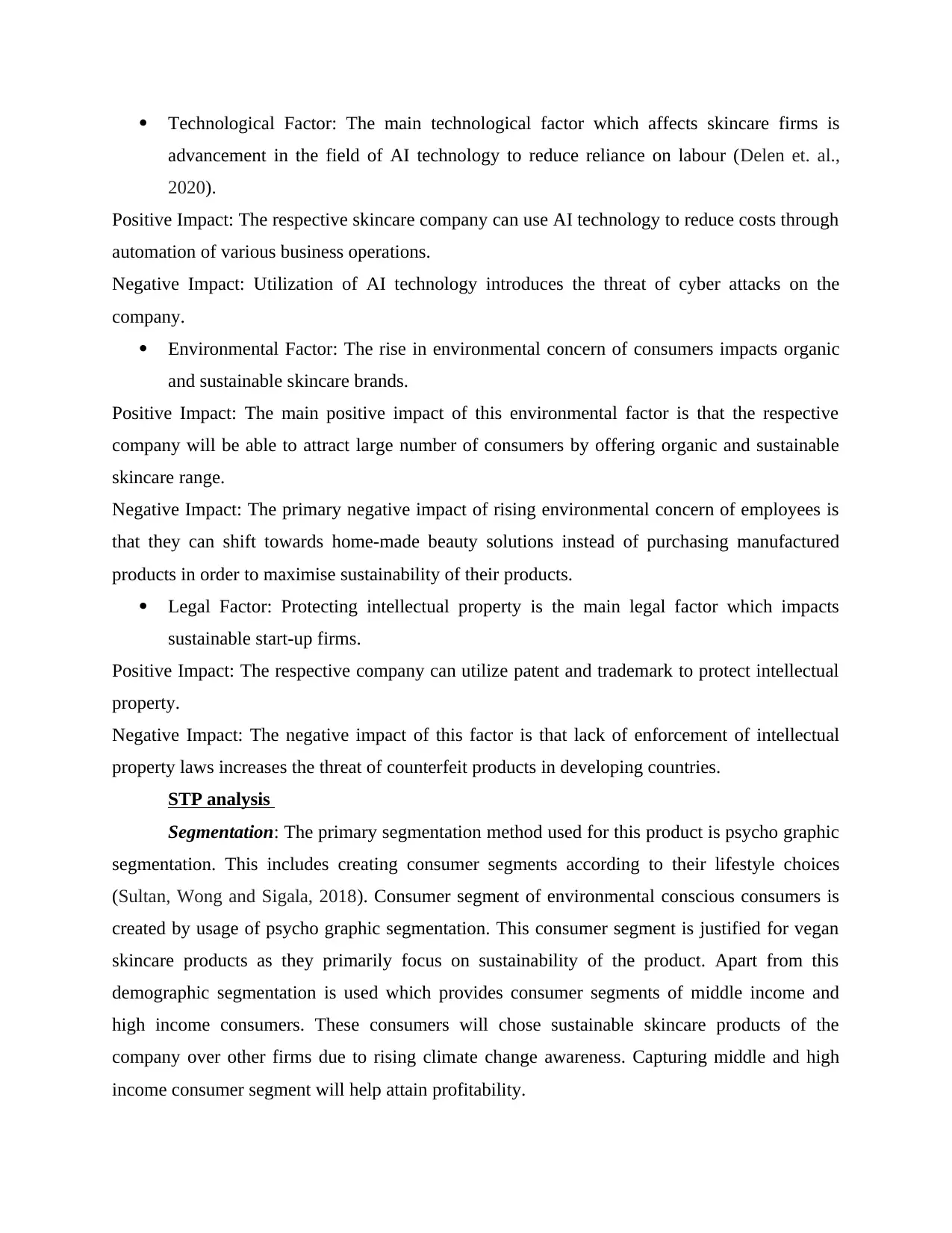
Technological Factor: The main technological factor which affects skincare firms is
advancement in the field of AI technology to reduce reliance on labour (Delen et. al.,
2020).
Positive Impact: The respective skincare company can use AI technology to reduce costs through
automation of various business operations.
Negative Impact: Utilization of AI technology introduces the threat of cyber attacks on the
company.
Environmental Factor: The rise in environmental concern of consumers impacts organic
and sustainable skincare brands.
Positive Impact: The main positive impact of this environmental factor is that the respective
company will be able to attract large number of consumers by offering organic and sustainable
skincare range.
Negative Impact: The primary negative impact of rising environmental concern of employees is
that they can shift towards home-made beauty solutions instead of purchasing manufactured
products in order to maximise sustainability of their products.
Legal Factor: Protecting intellectual property is the main legal factor which impacts
sustainable start-up firms.
Positive Impact: The respective company can utilize patent and trademark to protect intellectual
property.
Negative Impact: The negative impact of this factor is that lack of enforcement of intellectual
property laws increases the threat of counterfeit products in developing countries.
STP analysis
Segmentation: The primary segmentation method used for this product is psycho graphic
segmentation. This includes creating consumer segments according to their lifestyle choices
(Sultan, Wong and Sigala, 2018). Consumer segment of environmental conscious consumers is
created by usage of psycho graphic segmentation. This consumer segment is justified for vegan
skincare products as they primarily focus on sustainability of the product. Apart from this
demographic segmentation is used which provides consumer segments of middle income and
high income consumers. These consumers will chose sustainable skincare products of the
company over other firms due to rising climate change awareness. Capturing middle and high
income consumer segment will help attain profitability.
advancement in the field of AI technology to reduce reliance on labour (Delen et. al.,
2020).
Positive Impact: The respective skincare company can use AI technology to reduce costs through
automation of various business operations.
Negative Impact: Utilization of AI technology introduces the threat of cyber attacks on the
company.
Environmental Factor: The rise in environmental concern of consumers impacts organic
and sustainable skincare brands.
Positive Impact: The main positive impact of this environmental factor is that the respective
company will be able to attract large number of consumers by offering organic and sustainable
skincare range.
Negative Impact: The primary negative impact of rising environmental concern of employees is
that they can shift towards home-made beauty solutions instead of purchasing manufactured
products in order to maximise sustainability of their products.
Legal Factor: Protecting intellectual property is the main legal factor which impacts
sustainable start-up firms.
Positive Impact: The respective company can utilize patent and trademark to protect intellectual
property.
Negative Impact: The negative impact of this factor is that lack of enforcement of intellectual
property laws increases the threat of counterfeit products in developing countries.
STP analysis
Segmentation: The primary segmentation method used for this product is psycho graphic
segmentation. This includes creating consumer segments according to their lifestyle choices
(Sultan, Wong and Sigala, 2018). Consumer segment of environmental conscious consumers is
created by usage of psycho graphic segmentation. This consumer segment is justified for vegan
skincare products as they primarily focus on sustainability of the product. Apart from this
demographic segmentation is used which provides consumer segments of middle income and
high income consumers. These consumers will chose sustainable skincare products of the
company over other firms due to rising climate change awareness. Capturing middle and high
income consumer segment will help attain profitability.
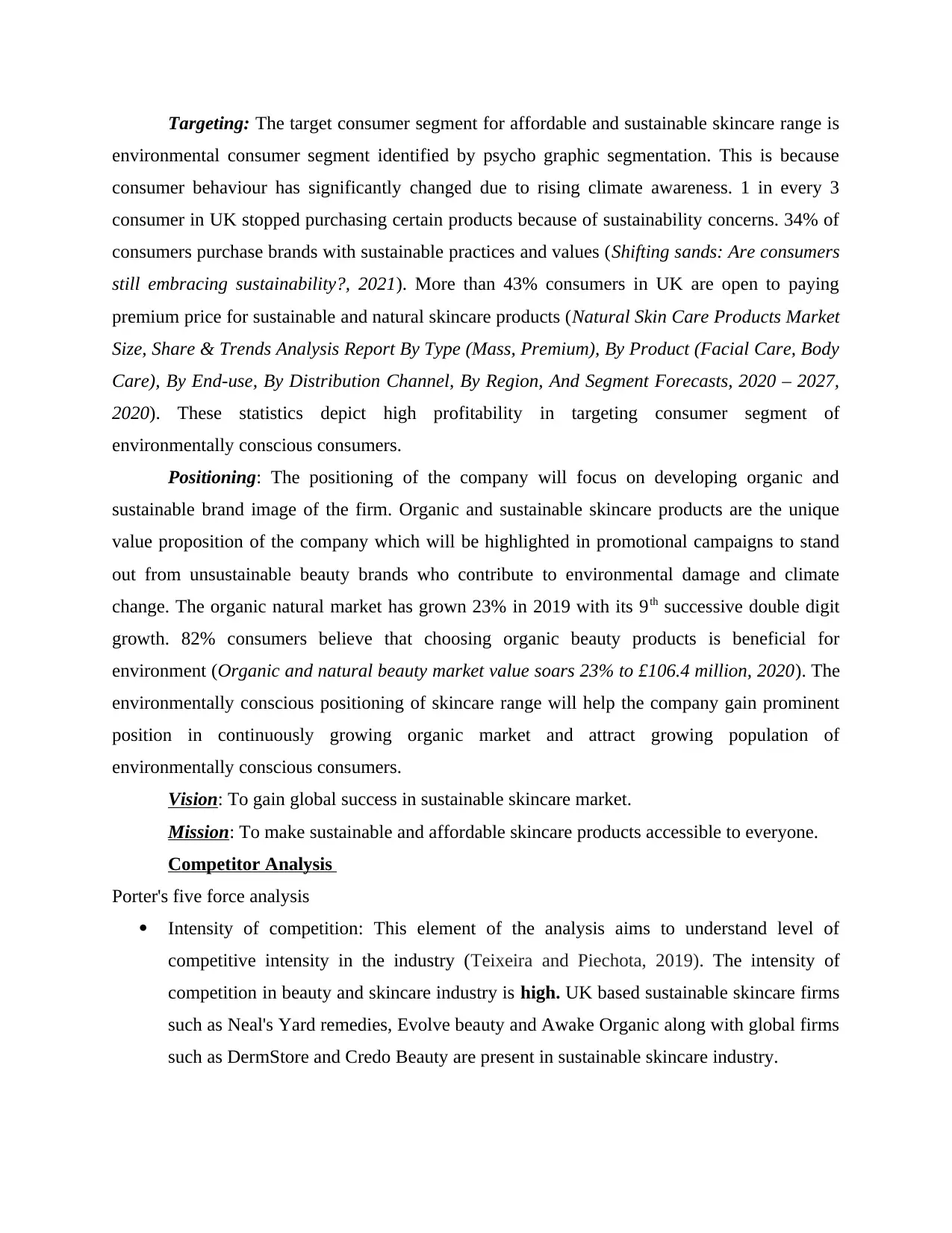
Targeting: The target consumer segment for affordable and sustainable skincare range is
environmental consumer segment identified by psycho graphic segmentation. This is because
consumer behaviour has significantly changed due to rising climate awareness. 1 in every 3
consumer in UK stopped purchasing certain products because of sustainability concerns. 34% of
consumers purchase brands with sustainable practices and values (Shifting sands: Are consumers
still embracing sustainability?, 2021). More than 43% consumers in UK are open to paying
premium price for sustainable and natural skincare products (Natural Skin Care Products Market
Size, Share & Trends Analysis Report By Type (Mass, Premium), By Product (Facial Care, Body
Care), By End-use, By Distribution Channel, By Region, And Segment Forecasts, 2020 – 2027,
2020). These statistics depict high profitability in targeting consumer segment of
environmentally conscious consumers.
Positioning: The positioning of the company will focus on developing organic and
sustainable brand image of the firm. Organic and sustainable skincare products are the unique
value proposition of the company which will be highlighted in promotional campaigns to stand
out from unsustainable beauty brands who contribute to environmental damage and climate
change. The organic natural market has grown 23% in 2019 with its 9th successive double digit
growth. 82% consumers believe that choosing organic beauty products is beneficial for
environment (Organic and natural beauty market value soars 23% to £106.4 million, 2020). The
environmentally conscious positioning of skincare range will help the company gain prominent
position in continuously growing organic market and attract growing population of
environmentally conscious consumers.
Vision: To gain global success in sustainable skincare market.
Mission: To make sustainable and affordable skincare products accessible to everyone.
Competitor Analysis
Porter's five force analysis
Intensity of competition: This element of the analysis aims to understand level of
competitive intensity in the industry (Teixeira and Piechota, 2019). The intensity of
competition in beauty and skincare industry is high. UK based sustainable skincare firms
such as Neal's Yard remedies, Evolve beauty and Awake Organic along with global firms
such as DermStore and Credo Beauty are present in sustainable skincare industry.
environmental consumer segment identified by psycho graphic segmentation. This is because
consumer behaviour has significantly changed due to rising climate awareness. 1 in every 3
consumer in UK stopped purchasing certain products because of sustainability concerns. 34% of
consumers purchase brands with sustainable practices and values (Shifting sands: Are consumers
still embracing sustainability?, 2021). More than 43% consumers in UK are open to paying
premium price for sustainable and natural skincare products (Natural Skin Care Products Market
Size, Share & Trends Analysis Report By Type (Mass, Premium), By Product (Facial Care, Body
Care), By End-use, By Distribution Channel, By Region, And Segment Forecasts, 2020 – 2027,
2020). These statistics depict high profitability in targeting consumer segment of
environmentally conscious consumers.
Positioning: The positioning of the company will focus on developing organic and
sustainable brand image of the firm. Organic and sustainable skincare products are the unique
value proposition of the company which will be highlighted in promotional campaigns to stand
out from unsustainable beauty brands who contribute to environmental damage and climate
change. The organic natural market has grown 23% in 2019 with its 9th successive double digit
growth. 82% consumers believe that choosing organic beauty products is beneficial for
environment (Organic and natural beauty market value soars 23% to £106.4 million, 2020). The
environmentally conscious positioning of skincare range will help the company gain prominent
position in continuously growing organic market and attract growing population of
environmentally conscious consumers.
Vision: To gain global success in sustainable skincare market.
Mission: To make sustainable and affordable skincare products accessible to everyone.
Competitor Analysis
Porter's five force analysis
Intensity of competition: This element of the analysis aims to understand level of
competitive intensity in the industry (Teixeira and Piechota, 2019). The intensity of
competition in beauty and skincare industry is high. UK based sustainable skincare firms
such as Neal's Yard remedies, Evolve beauty and Awake Organic along with global firms
such as DermStore and Credo Beauty are present in sustainable skincare industry.
⊘ This is a preview!⊘
Do you want full access?
Subscribe today to unlock all pages.

Trusted by 1+ million students worldwide
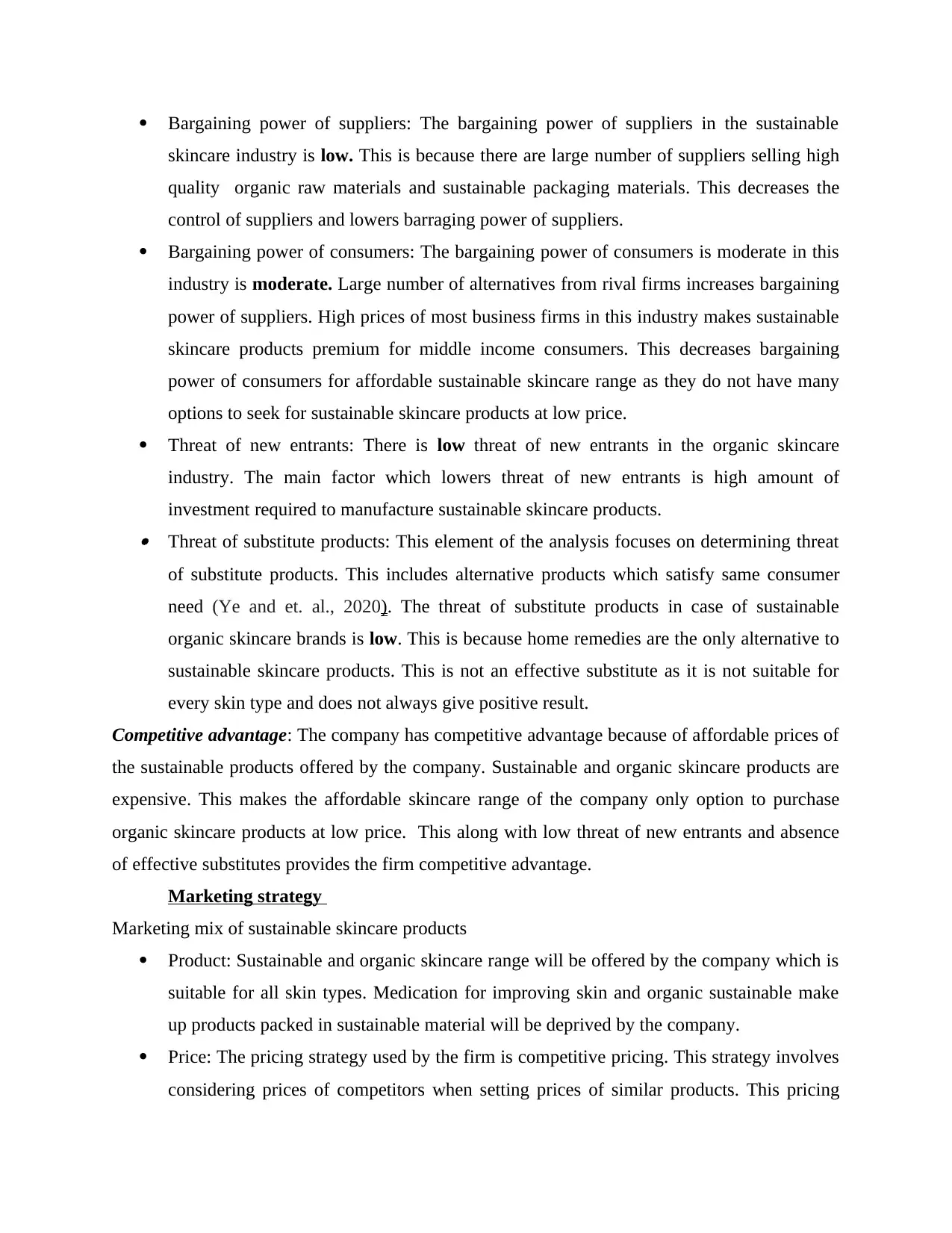
Bargaining power of suppliers: The bargaining power of suppliers in the sustainable
skincare industry is low. This is because there are large number of suppliers selling high
quality organic raw materials and sustainable packaging materials. This decreases the
control of suppliers and lowers barraging power of suppliers.
Bargaining power of consumers: The bargaining power of consumers is moderate in this
industry is moderate. Large number of alternatives from rival firms increases bargaining
power of suppliers. High prices of most business firms in this industry makes sustainable
skincare products premium for middle income consumers. This decreases bargaining
power of consumers for affordable sustainable skincare range as they do not have many
options to seek for sustainable skincare products at low price.
Threat of new entrants: There is low threat of new entrants in the organic skincare
industry. The main factor which lowers threat of new entrants is high amount of
investment required to manufacture sustainable skincare products. Threat of substitute products: This element of the analysis focuses on determining threat
of substitute products. This includes alternative products which satisfy same consumer
need (Ye and et. al., 2020). The threat of substitute products in case of sustainable
organic skincare brands is low. This is because home remedies are the only alternative to
sustainable skincare products. This is not an effective substitute as it is not suitable for
every skin type and does not always give positive result.
Competitive advantage: The company has competitive advantage because of affordable prices of
the sustainable products offered by the company. Sustainable and organic skincare products are
expensive. This makes the affordable skincare range of the company only option to purchase
organic skincare products at low price. This along with low threat of new entrants and absence
of effective substitutes provides the firm competitive advantage.
Marketing strategy
Marketing mix of sustainable skincare products
Product: Sustainable and organic skincare range will be offered by the company which is
suitable for all skin types. Medication for improving skin and organic sustainable make
up products packed in sustainable material will be deprived by the company.
Price: The pricing strategy used by the firm is competitive pricing. This strategy involves
considering prices of competitors when setting prices of similar products. This pricing
skincare industry is low. This is because there are large number of suppliers selling high
quality organic raw materials and sustainable packaging materials. This decreases the
control of suppliers and lowers barraging power of suppliers.
Bargaining power of consumers: The bargaining power of consumers is moderate in this
industry is moderate. Large number of alternatives from rival firms increases bargaining
power of suppliers. High prices of most business firms in this industry makes sustainable
skincare products premium for middle income consumers. This decreases bargaining
power of consumers for affordable sustainable skincare range as they do not have many
options to seek for sustainable skincare products at low price.
Threat of new entrants: There is low threat of new entrants in the organic skincare
industry. The main factor which lowers threat of new entrants is high amount of
investment required to manufacture sustainable skincare products. Threat of substitute products: This element of the analysis focuses on determining threat
of substitute products. This includes alternative products which satisfy same consumer
need (Ye and et. al., 2020). The threat of substitute products in case of sustainable
organic skincare brands is low. This is because home remedies are the only alternative to
sustainable skincare products. This is not an effective substitute as it is not suitable for
every skin type and does not always give positive result.
Competitive advantage: The company has competitive advantage because of affordable prices of
the sustainable products offered by the company. Sustainable and organic skincare products are
expensive. This makes the affordable skincare range of the company only option to purchase
organic skincare products at low price. This along with low threat of new entrants and absence
of effective substitutes provides the firm competitive advantage.
Marketing strategy
Marketing mix of sustainable skincare products
Product: Sustainable and organic skincare range will be offered by the company which is
suitable for all skin types. Medication for improving skin and organic sustainable make
up products packed in sustainable material will be deprived by the company.
Price: The pricing strategy used by the firm is competitive pricing. This strategy involves
considering prices of competitors when setting prices of similar products. This pricing
Paraphrase This Document
Need a fresh take? Get an instant paraphrase of this document with our AI Paraphraser
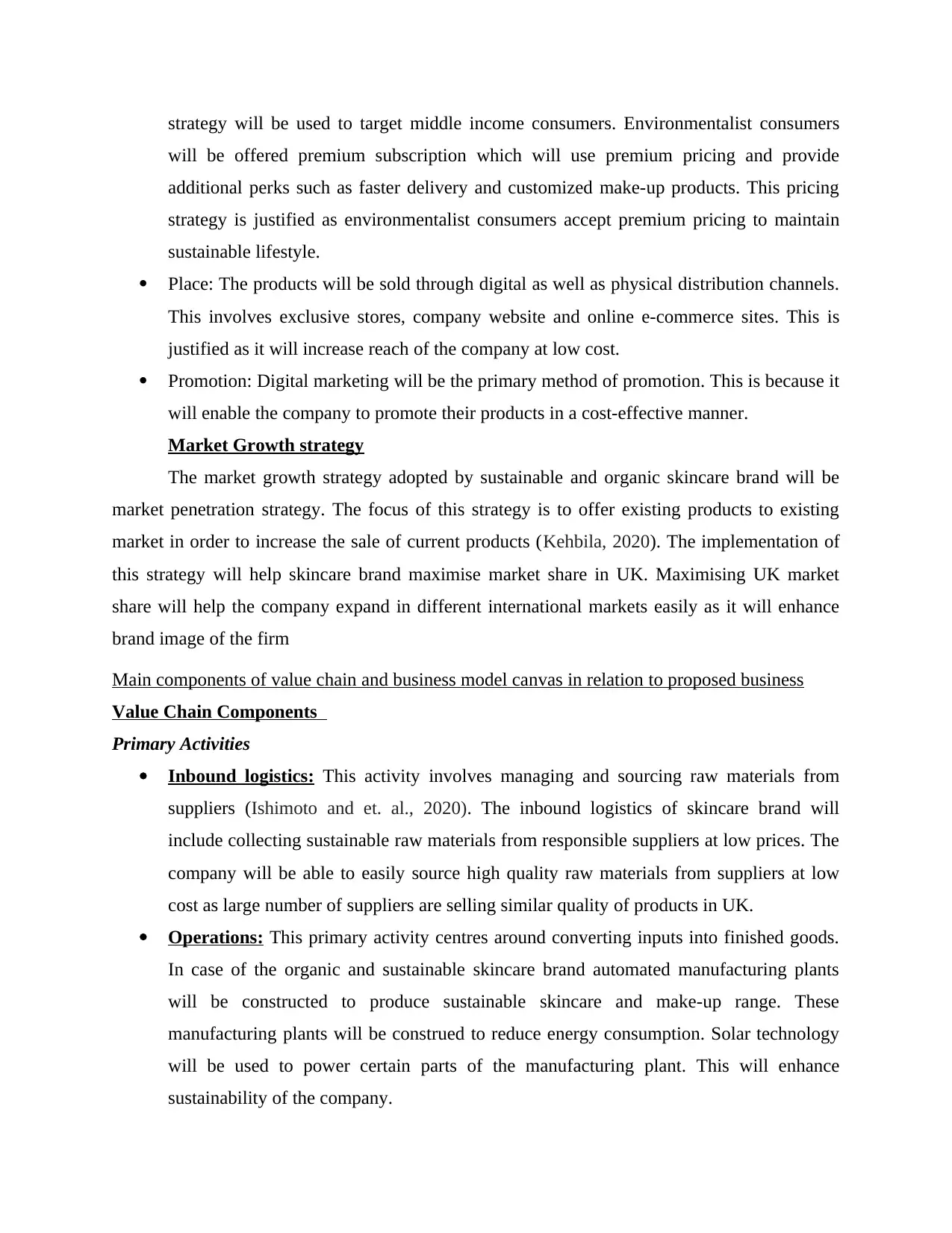
strategy will be used to target middle income consumers. Environmentalist consumers
will be offered premium subscription which will use premium pricing and provide
additional perks such as faster delivery and customized make-up products. This pricing
strategy is justified as environmentalist consumers accept premium pricing to maintain
sustainable lifestyle.
Place: The products will be sold through digital as well as physical distribution channels.
This involves exclusive stores, company website and online e-commerce sites. This is
justified as it will increase reach of the company at low cost.
Promotion: Digital marketing will be the primary method of promotion. This is because it
will enable the company to promote their products in a cost-effective manner.
Market Growth strategy
The market growth strategy adopted by sustainable and organic skincare brand will be
market penetration strategy. The focus of this strategy is to offer existing products to existing
market in order to increase the sale of current products (Kehbila, 2020). The implementation of
this strategy will help skincare brand maximise market share in UK. Maximising UK market
share will help the company expand in different international markets easily as it will enhance
brand image of the firm
Main components of value chain and business model canvas in relation to proposed business
Value Chain Components
Primary Activities
Inbound logistics: This activity involves managing and sourcing raw materials from
suppliers (Ishimoto and et. al., 2020). The inbound logistics of skincare brand will
include collecting sustainable raw materials from responsible suppliers at low prices. The
company will be able to easily source high quality raw materials from suppliers at low
cost as large number of suppliers are selling similar quality of products in UK.
Operations: This primary activity centres around converting inputs into finished goods.
In case of the organic and sustainable skincare brand automated manufacturing plants
will be constructed to produce sustainable skincare and make-up range. These
manufacturing plants will be construed to reduce energy consumption. Solar technology
will be used to power certain parts of the manufacturing plant. This will enhance
sustainability of the company.
will be offered premium subscription which will use premium pricing and provide
additional perks such as faster delivery and customized make-up products. This pricing
strategy is justified as environmentalist consumers accept premium pricing to maintain
sustainable lifestyle.
Place: The products will be sold through digital as well as physical distribution channels.
This involves exclusive stores, company website and online e-commerce sites. This is
justified as it will increase reach of the company at low cost.
Promotion: Digital marketing will be the primary method of promotion. This is because it
will enable the company to promote their products in a cost-effective manner.
Market Growth strategy
The market growth strategy adopted by sustainable and organic skincare brand will be
market penetration strategy. The focus of this strategy is to offer existing products to existing
market in order to increase the sale of current products (Kehbila, 2020). The implementation of
this strategy will help skincare brand maximise market share in UK. Maximising UK market
share will help the company expand in different international markets easily as it will enhance
brand image of the firm
Main components of value chain and business model canvas in relation to proposed business
Value Chain Components
Primary Activities
Inbound logistics: This activity involves managing and sourcing raw materials from
suppliers (Ishimoto and et. al., 2020). The inbound logistics of skincare brand will
include collecting sustainable raw materials from responsible suppliers at low prices. The
company will be able to easily source high quality raw materials from suppliers at low
cost as large number of suppliers are selling similar quality of products in UK.
Operations: This primary activity centres around converting inputs into finished goods.
In case of the organic and sustainable skincare brand automated manufacturing plants
will be constructed to produce sustainable skincare and make-up range. These
manufacturing plants will be construed to reduce energy consumption. Solar technology
will be used to power certain parts of the manufacturing plant. This will enhance
sustainability of the company.
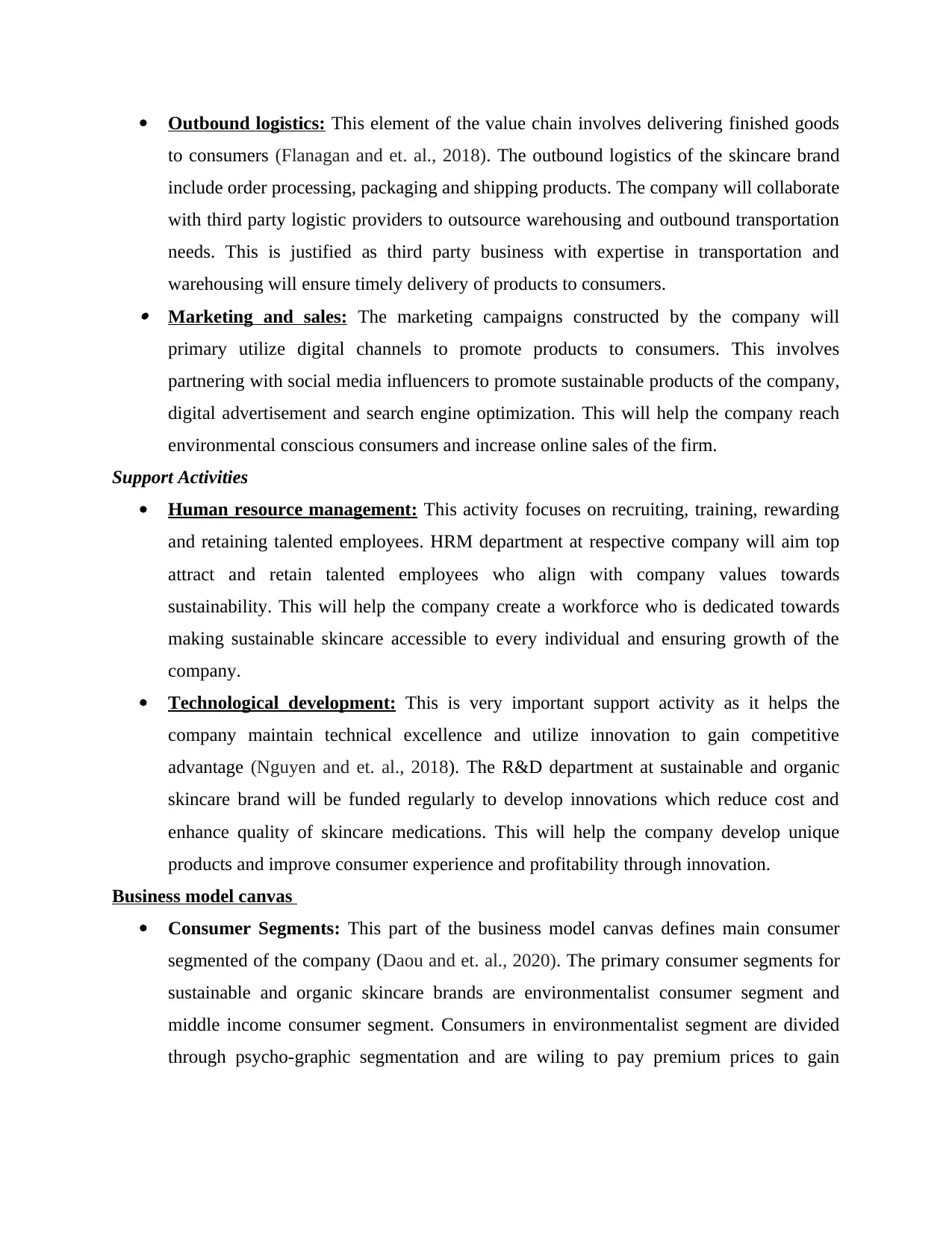
Outbound logistics: This element of the value chain involves delivering finished goods
to consumers (Flanagan and et. al., 2018). The outbound logistics of the skincare brand
include order processing, packaging and shipping products. The company will collaborate
with third party logistic providers to outsource warehousing and outbound transportation
needs. This is justified as third party business with expertise in transportation and
warehousing will ensure timely delivery of products to consumers. Marketing and sales: The marketing campaigns constructed by the company will
primary utilize digital channels to promote products to consumers. This involves
partnering with social media influencers to promote sustainable products of the company,
digital advertisement and search engine optimization. This will help the company reach
environmental conscious consumers and increase online sales of the firm.
Support Activities
Human resource management: This activity focuses on recruiting, training, rewarding
and retaining talented employees. HRM department at respective company will aim top
attract and retain talented employees who align with company values towards
sustainability. This will help the company create a workforce who is dedicated towards
making sustainable skincare accessible to every individual and ensuring growth of the
company.
Technological development: This is very important support activity as it helps the
company maintain technical excellence and utilize innovation to gain competitive
advantage (Nguyen and et. al., 2018). The R&D department at sustainable and organic
skincare brand will be funded regularly to develop innovations which reduce cost and
enhance quality of skincare medications. This will help the company develop unique
products and improve consumer experience and profitability through innovation.
Business model canvas
Consumer Segments: This part of the business model canvas defines main consumer
segmented of the company (Daou and et. al., 2020). The primary consumer segments for
sustainable and organic skincare brands are environmentalist consumer segment and
middle income consumer segment. Consumers in environmentalist segment are divided
through psycho-graphic segmentation and are wiling to pay premium prices to gain
to consumers (Flanagan and et. al., 2018). The outbound logistics of the skincare brand
include order processing, packaging and shipping products. The company will collaborate
with third party logistic providers to outsource warehousing and outbound transportation
needs. This is justified as third party business with expertise in transportation and
warehousing will ensure timely delivery of products to consumers. Marketing and sales: The marketing campaigns constructed by the company will
primary utilize digital channels to promote products to consumers. This involves
partnering with social media influencers to promote sustainable products of the company,
digital advertisement and search engine optimization. This will help the company reach
environmental conscious consumers and increase online sales of the firm.
Support Activities
Human resource management: This activity focuses on recruiting, training, rewarding
and retaining talented employees. HRM department at respective company will aim top
attract and retain talented employees who align with company values towards
sustainability. This will help the company create a workforce who is dedicated towards
making sustainable skincare accessible to every individual and ensuring growth of the
company.
Technological development: This is very important support activity as it helps the
company maintain technical excellence and utilize innovation to gain competitive
advantage (Nguyen and et. al., 2018). The R&D department at sustainable and organic
skincare brand will be funded regularly to develop innovations which reduce cost and
enhance quality of skincare medications. This will help the company develop unique
products and improve consumer experience and profitability through innovation.
Business model canvas
Consumer Segments: This part of the business model canvas defines main consumer
segmented of the company (Daou and et. al., 2020). The primary consumer segments for
sustainable and organic skincare brands are environmentalist consumer segment and
middle income consumer segment. Consumers in environmentalist segment are divided
through psycho-graphic segmentation and are wiling to pay premium prices to gain
⊘ This is a preview!⊘
Do you want full access?
Subscribe today to unlock all pages.

Trusted by 1+ million students worldwide
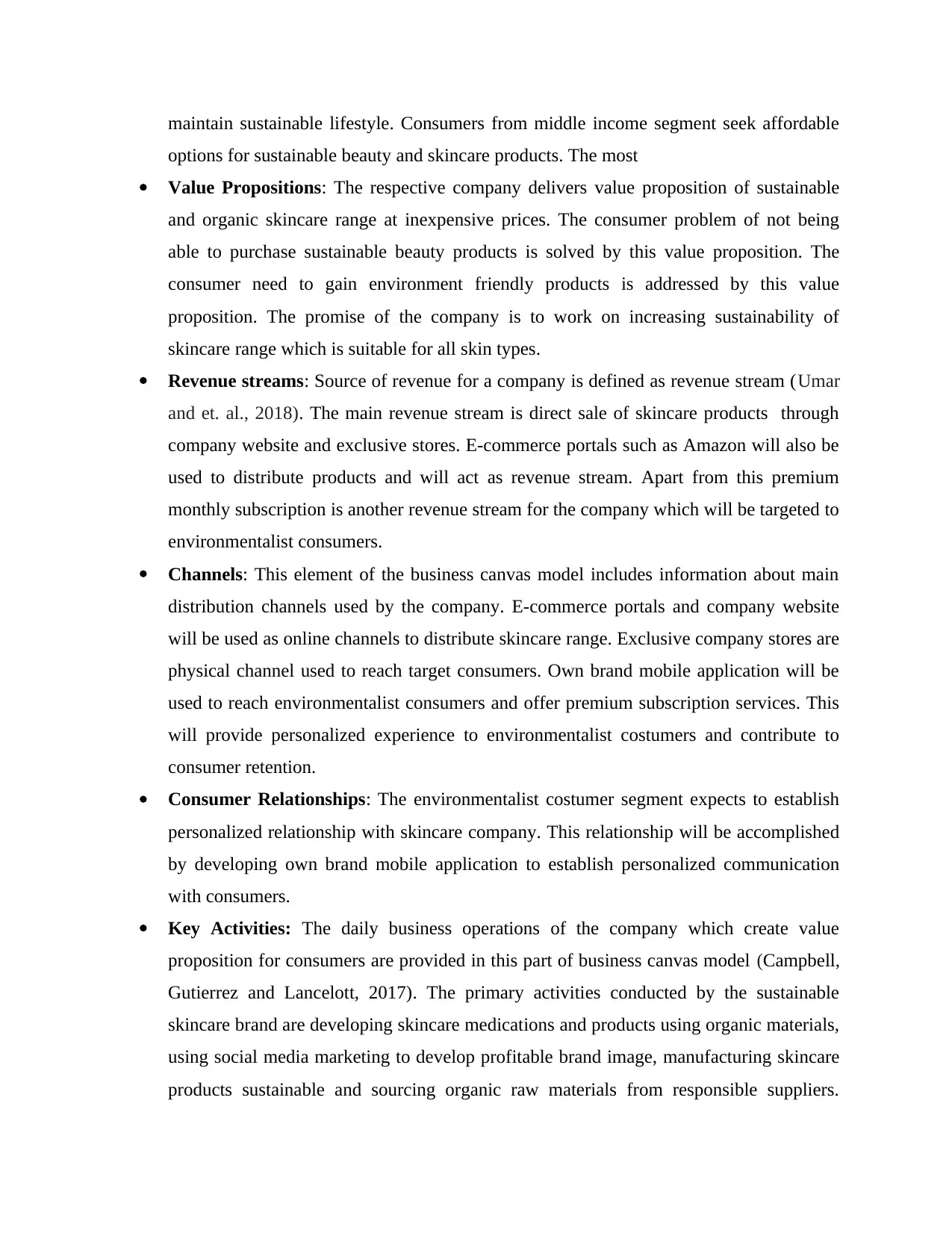
maintain sustainable lifestyle. Consumers from middle income segment seek affordable
options for sustainable beauty and skincare products. The most
Value Propositions: The respective company delivers value proposition of sustainable
and organic skincare range at inexpensive prices. The consumer problem of not being
able to purchase sustainable beauty products is solved by this value proposition. The
consumer need to gain environment friendly products is addressed by this value
proposition. The promise of the company is to work on increasing sustainability of
skincare range which is suitable for all skin types.
Revenue streams: Source of revenue for a company is defined as revenue stream (Umar
and et. al., 2018). The main revenue stream is direct sale of skincare products through
company website and exclusive stores. E-commerce portals such as Amazon will also be
used to distribute products and will act as revenue stream. Apart from this premium
monthly subscription is another revenue stream for the company which will be targeted to
environmentalist consumers.
Channels: This element of the business canvas model includes information about main
distribution channels used by the company. E-commerce portals and company website
will be used as online channels to distribute skincare range. Exclusive company stores are
physical channel used to reach target consumers. Own brand mobile application will be
used to reach environmentalist consumers and offer premium subscription services. This
will provide personalized experience to environmentalist costumers and contribute to
consumer retention.
Consumer Relationships: The environmentalist costumer segment expects to establish
personalized relationship with skincare company. This relationship will be accomplished
by developing own brand mobile application to establish personalized communication
with consumers.
Key Activities: The daily business operations of the company which create value
proposition for consumers are provided in this part of business canvas model (Campbell,
Gutierrez and Lancelott, 2017). The primary activities conducted by the sustainable
skincare brand are developing skincare medications and products using organic materials,
using social media marketing to develop profitable brand image, manufacturing skincare
products sustainable and sourcing organic raw materials from responsible suppliers.
options for sustainable beauty and skincare products. The most
Value Propositions: The respective company delivers value proposition of sustainable
and organic skincare range at inexpensive prices. The consumer problem of not being
able to purchase sustainable beauty products is solved by this value proposition. The
consumer need to gain environment friendly products is addressed by this value
proposition. The promise of the company is to work on increasing sustainability of
skincare range which is suitable for all skin types.
Revenue streams: Source of revenue for a company is defined as revenue stream (Umar
and et. al., 2018). The main revenue stream is direct sale of skincare products through
company website and exclusive stores. E-commerce portals such as Amazon will also be
used to distribute products and will act as revenue stream. Apart from this premium
monthly subscription is another revenue stream for the company which will be targeted to
environmentalist consumers.
Channels: This element of the business canvas model includes information about main
distribution channels used by the company. E-commerce portals and company website
will be used as online channels to distribute skincare range. Exclusive company stores are
physical channel used to reach target consumers. Own brand mobile application will be
used to reach environmentalist consumers and offer premium subscription services. This
will provide personalized experience to environmentalist costumers and contribute to
consumer retention.
Consumer Relationships: The environmentalist costumer segment expects to establish
personalized relationship with skincare company. This relationship will be accomplished
by developing own brand mobile application to establish personalized communication
with consumers.
Key Activities: The daily business operations of the company which create value
proposition for consumers are provided in this part of business canvas model (Campbell,
Gutierrez and Lancelott, 2017). The primary activities conducted by the sustainable
skincare brand are developing skincare medications and products using organic materials,
using social media marketing to develop profitable brand image, manufacturing skincare
products sustainable and sourcing organic raw materials from responsible suppliers.
Paraphrase This Document
Need a fresh take? Get an instant paraphrase of this document with our AI Paraphraser
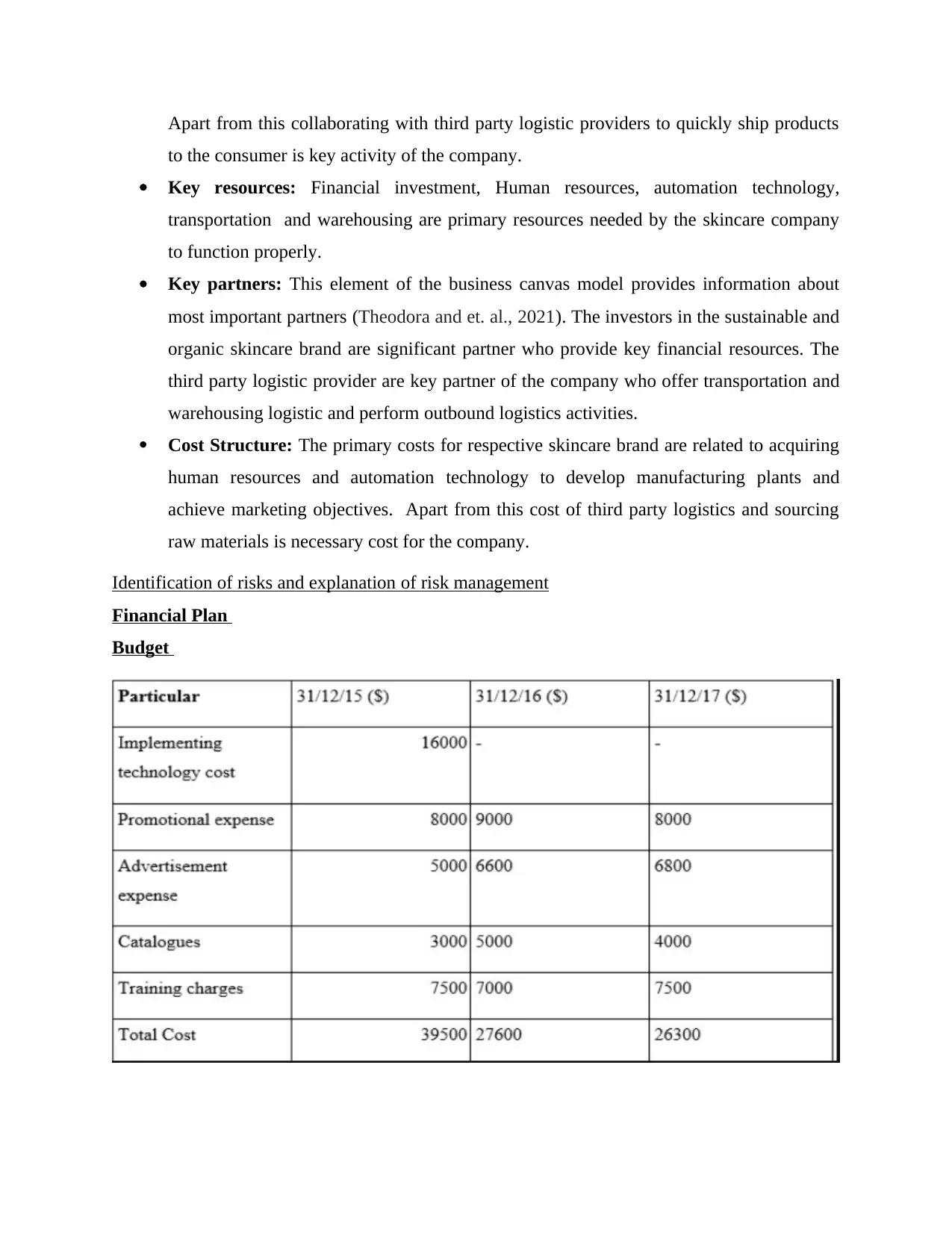
Apart from this collaborating with third party logistic providers to quickly ship products
to the consumer is key activity of the company.
Key resources: Financial investment, Human resources, automation technology,
transportation and warehousing are primary resources needed by the skincare company
to function properly.
Key partners: This element of the business canvas model provides information about
most important partners (Theodora and et. al., 2021). The investors in the sustainable and
organic skincare brand are significant partner who provide key financial resources. The
third party logistic provider are key partner of the company who offer transportation and
warehousing logistic and perform outbound logistics activities.
Cost Structure: The primary costs for respective skincare brand are related to acquiring
human resources and automation technology to develop manufacturing plants and
achieve marketing objectives. Apart from this cost of third party logistics and sourcing
raw materials is necessary cost for the company.
Identification of risks and explanation of risk management
Financial Plan
Budget
to the consumer is key activity of the company.
Key resources: Financial investment, Human resources, automation technology,
transportation and warehousing are primary resources needed by the skincare company
to function properly.
Key partners: This element of the business canvas model provides information about
most important partners (Theodora and et. al., 2021). The investors in the sustainable and
organic skincare brand are significant partner who provide key financial resources. The
third party logistic provider are key partner of the company who offer transportation and
warehousing logistic and perform outbound logistics activities.
Cost Structure: The primary costs for respective skincare brand are related to acquiring
human resources and automation technology to develop manufacturing plants and
achieve marketing objectives. Apart from this cost of third party logistics and sourcing
raw materials is necessary cost for the company.
Identification of risks and explanation of risk management
Financial Plan
Budget
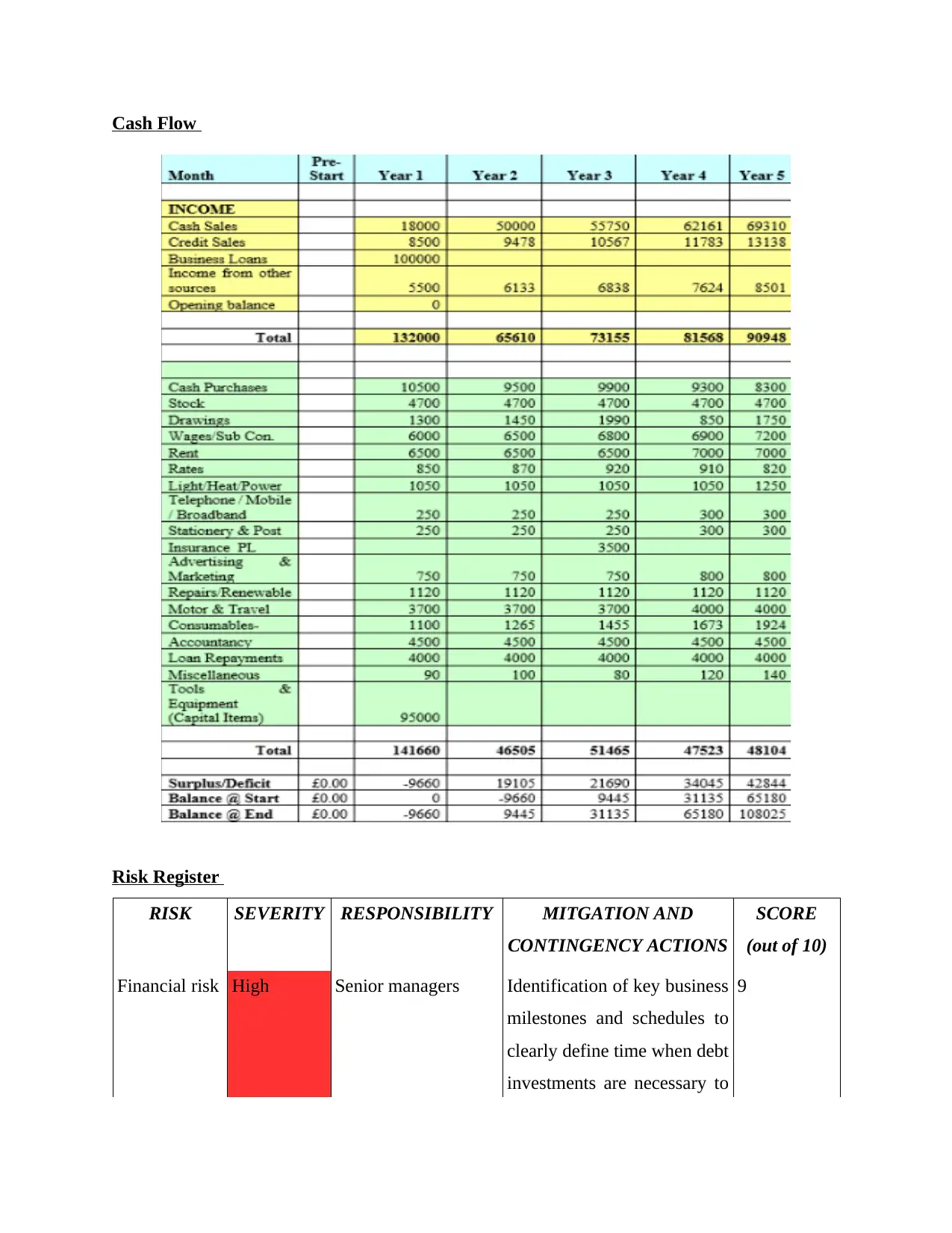
Cash Flow
Risk Register
RISK SEVERITY RESPONSIBILITY MITGATION AND
CONTINGENCY ACTIONS
SCORE
(out of 10)
Financial risk High Senior managers Identification of key business
milestones and schedules to
clearly define time when debt
investments are necessary to
9
Risk Register
RISK SEVERITY RESPONSIBILITY MITGATION AND
CONTINGENCY ACTIONS
SCORE
(out of 10)
Financial risk High Senior managers Identification of key business
milestones and schedules to
clearly define time when debt
investments are necessary to
9
⊘ This is a preview!⊘
Do you want full access?
Subscribe today to unlock all pages.

Trusted by 1+ million students worldwide
1 out of 17
Related Documents
Your All-in-One AI-Powered Toolkit for Academic Success.
+13062052269
info@desklib.com
Available 24*7 on WhatsApp / Email
![[object Object]](/_next/static/media/star-bottom.7253800d.svg)
Unlock your academic potential
Copyright © 2020–2025 A2Z Services. All Rights Reserved. Developed and managed by ZUCOL.



